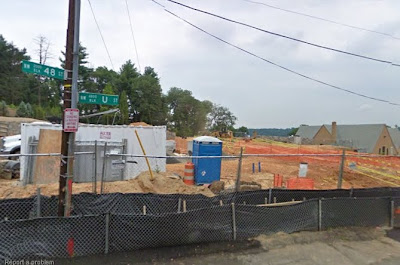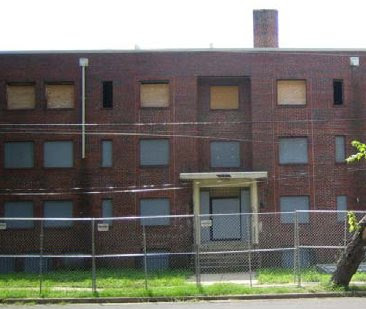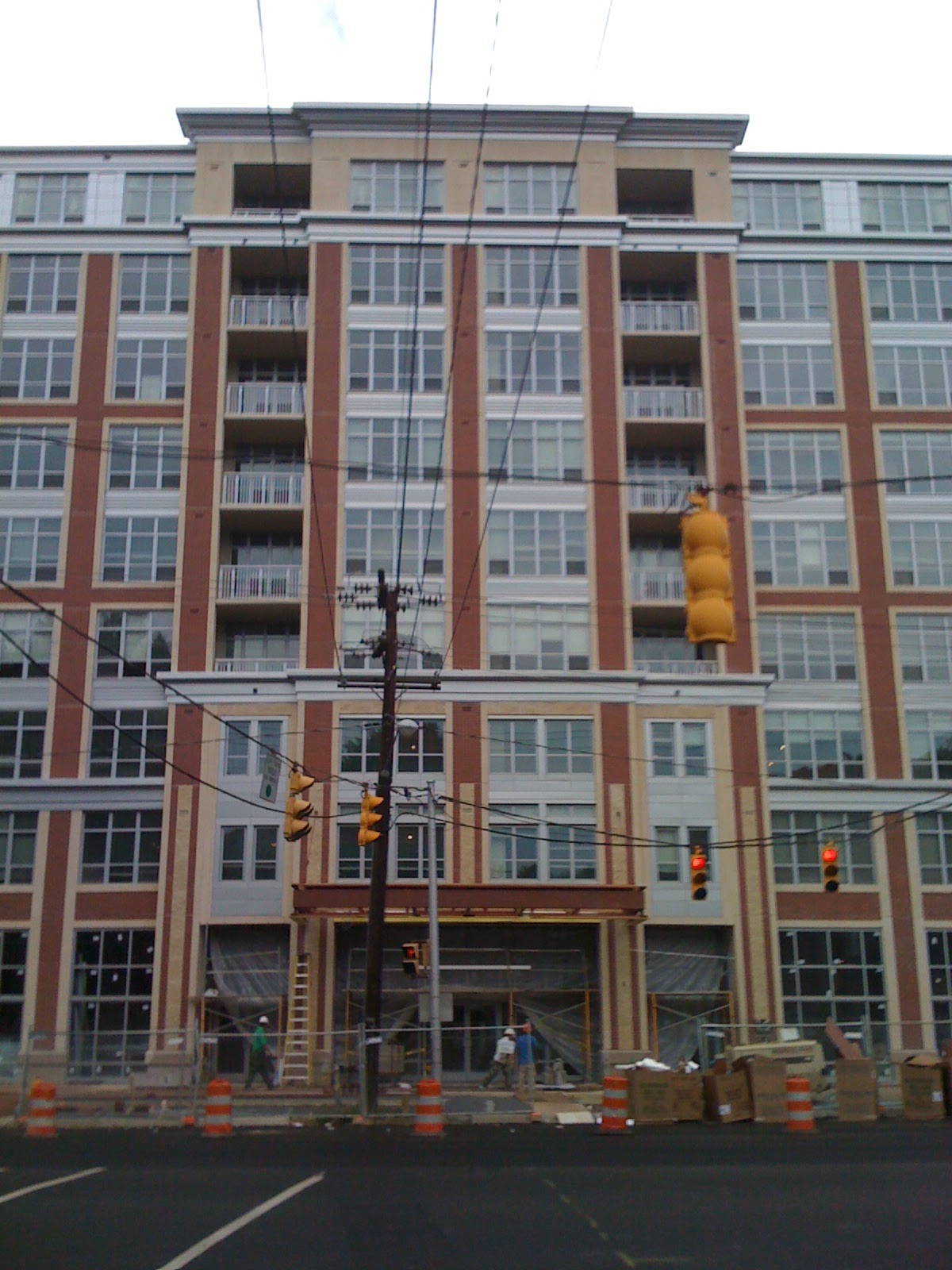
 Today, neighbors of Eastern Market got an answer to a long-outstanding question: What will go in the place of the former Hine Junior High School on Capitol Hill? Washington DC officials announced that Stanton-EastBanc had won the right to develop, with a plan that includes a mix of retail, residential and open space to appease the outspoken Capitol Hill neighborhood. The project may break ground as soon as 2011.
The selected team includes Stanton Development Corporation, Eastbanc Inc., Dantes Partners and Weinstein Esocoff Architects. The plan for the 3.5 acre lot in Capitol Hill's Eastern Market neighborhood calls for a total of 510,000 s.f. of total development. The new development will include approximately 150 apartments and over 200,000 s.f. of office space. Currently slated for the spaces are the nonprofit International Relief and Development and the Shakespeare Theatre Company. Additionally, the space will offer 150 parking spaces and "neighborhood-serving retail and restaurants."
Stanton appears to have gotten the upper hand for several reasons. The group is entirely DC-based, has a proven track record in several buildings in the Capitol Hill area and did not request any subsidy from the District for the project.
Today, neighbors of Eastern Market got an answer to a long-outstanding question: What will go in the place of the former Hine Junior High School on Capitol Hill? Washington DC officials announced that Stanton-EastBanc had won the right to develop, with a plan that includes a mix of retail, residential and open space to appease the outspoken Capitol Hill neighborhood. The project may break ground as soon as 2011.
The selected team includes Stanton Development Corporation, Eastbanc Inc., Dantes Partners and Weinstein Esocoff Architects. The plan for the 3.5 acre lot in Capitol Hill's Eastern Market neighborhood calls for a total of 510,000 s.f. of total development. The new development will include approximately 150 apartments and over 200,000 s.f. of office space. Currently slated for the spaces are the nonprofit International Relief and Development and the Shakespeare Theatre Company. Additionally, the space will offer 150 parking spaces and "neighborhood-serving retail and restaurants."
Stanton appears to have gotten the upper hand for several reasons. The group is entirely DC-based, has a proven track record in several buildings in the Capitol Hill area and did not request any subsidy from the District for the project. With support from several active and outspoken Capitol Hill neighborhood groups, Stanton secured the project out of an original field of 11 bidders.
 The competitive project had the Eastern Market neighborhood a-buzz, forming coalitions in favor of one plan or another. Leah Daniels, owner of Hill's Kitchen in Eastern Market hosted meetings at her shop so the StreetSense/DSF/Menkiti Group could show off their plan. It would have included a boutique Kimpton Hotel, which Daniels felt - still feels - is an important addition to the neighborhood. Daniels said that while the group she wanted to win didn't, at least it wasn't the team she didn't want: Bozzuto Group/Scallan Properties/Lehr Jackson Associates/E.R. Bacon Development, LLC/Blue Skye Development/CityStrategy, LLC. She did credit the Stanton group for being willing to continue to work with the community to ensure that the space maximizes its location in the heart of the Eastern Market community.
According to Joe Sternlieb of EastBanc, the developers are looking for neighborhood-serving retail. They have letters of interest from restaurants including: Cafe Leopold, Kaz Sushi, Dolcezza Gelato, J. Cholatier, Tryst Diner by Constantine Stavropoulos, The Boat House Restaurant of Charlottesville and the Twins Jazz Club. Retail interest includes: Dawn Price Baby (looking to expand from current Hill location) and B&M Wine among others. Sternlieb indicated that retail spaces will be no larger than 5,000 s.f. each and will likely average 2,000-3,000 s.f. per tenant.
In July, the Deputy Mayor for Planning and Economic Development (DMPED), Valerie Santos, narrowed the field of competitors to three and encouraged them to submit final offers for the right to redevelop the site. The school was closed in 2007, in part to free up funds for the DCPS headquarters. Responses to the District’s request for final offers were due in early August.
The competitive project had the Eastern Market neighborhood a-buzz, forming coalitions in favor of one plan or another. Leah Daniels, owner of Hill's Kitchen in Eastern Market hosted meetings at her shop so the StreetSense/DSF/Menkiti Group could show off their plan. It would have included a boutique Kimpton Hotel, which Daniels felt - still feels - is an important addition to the neighborhood. Daniels said that while the group she wanted to win didn't, at least it wasn't the team she didn't want: Bozzuto Group/Scallan Properties/Lehr Jackson Associates/E.R. Bacon Development, LLC/Blue Skye Development/CityStrategy, LLC. She did credit the Stanton group for being willing to continue to work with the community to ensure that the space maximizes its location in the heart of the Eastern Market community.
According to Joe Sternlieb of EastBanc, the developers are looking for neighborhood-serving retail. They have letters of interest from restaurants including: Cafe Leopold, Kaz Sushi, Dolcezza Gelato, J. Cholatier, Tryst Diner by Constantine Stavropoulos, The Boat House Restaurant of Charlottesville and the Twins Jazz Club. Retail interest includes: Dawn Price Baby (looking to expand from current Hill location) and B&M Wine among others. Sternlieb indicated that retail spaces will be no larger than 5,000 s.f. each and will likely average 2,000-3,000 s.f. per tenant.
In July, the Deputy Mayor for Planning and Economic Development (DMPED), Valerie Santos, narrowed the field of competitors to three and encouraged them to submit final offers for the right to redevelop the site. The school was closed in 2007, in part to free up funds for the DCPS headquarters. Responses to the District’s request for final offers were due in early August. Today's announcement marks another high point in the vibrant neighborhood which recently saw the reopening of the Eastern Market after the fire that ravaged the historic structure in April 2007. Councilmember Tommy Wells (Ward 6) said that the new site should reflect how "special" the Capitol Hill neighborhood is and that the developers and the city have "a lot more work to do" to make sure the project enhances the neighborhood.
Today's announcement marks another high point in the vibrant neighborhood which recently saw the reopening of the Eastern Market after the fire that ravaged the historic structure in April 2007. Councilmember Tommy Wells (Ward 6) said that the new site should reflect how "special" the Capitol Hill neighborhood is and that the developers and the city have "a lot more work to do" to make sure the project enhances the neighborhood.
 The competitive project had the Eastern Market neighborhood a-buzz, forming coalitions in favor of one plan or another. Leah Daniels, owner of Hill's Kitchen in Eastern Market hosted meetings at her shop so the StreetSense/DSF/Menkiti Group could show off their plan. It would have included a boutique Kimpton Hotel, which Daniels felt - still feels - is an important addition to the neighborhood. Daniels said that while the group she wanted to win didn't, at least it wasn't the team she didn't want: Bozzuto Group/Scallan Properties/Lehr Jackson Associates/E.R. Bacon Development, LLC/Blue Skye Development/CityStrategy, LLC. She did credit the Stanton group for being willing to continue to work with the community to ensure that the space maximizes its location in the heart of the Eastern Market community.
According to Joe Sternlieb of EastBanc, the developers are looking for neighborhood-serving retail. They have letters of interest from restaurants including: Cafe Leopold, Kaz Sushi, Dolcezza Gelato, J. Cholatier, Tryst Diner by Constantine Stavropoulos, The Boat House Restaurant of Charlottesville and the Twins Jazz Club. Retail interest includes: Dawn Price Baby (looking to expand from current Hill location) and B&M Wine among others. Sternlieb indicated that retail spaces will be no larger than 5,000 s.f. each and will likely average 2,000-3,000 s.f. per tenant.
In July, the Deputy Mayor for Planning and Economic Development (DMPED), Valerie Santos, narrowed the field of competitors to three and encouraged them to submit final offers for the right to redevelop the site. The school was closed in 2007, in part to free up funds for the DCPS headquarters. Responses to the District’s request for final offers were due in early August.
The competitive project had the Eastern Market neighborhood a-buzz, forming coalitions in favor of one plan or another. Leah Daniels, owner of Hill's Kitchen in Eastern Market hosted meetings at her shop so the StreetSense/DSF/Menkiti Group could show off their plan. It would have included a boutique Kimpton Hotel, which Daniels felt - still feels - is an important addition to the neighborhood. Daniels said that while the group she wanted to win didn't, at least it wasn't the team she didn't want: Bozzuto Group/Scallan Properties/Lehr Jackson Associates/E.R. Bacon Development, LLC/Blue Skye Development/CityStrategy, LLC. She did credit the Stanton group for being willing to continue to work with the community to ensure that the space maximizes its location in the heart of the Eastern Market community.
According to Joe Sternlieb of EastBanc, the developers are looking for neighborhood-serving retail. They have letters of interest from restaurants including: Cafe Leopold, Kaz Sushi, Dolcezza Gelato, J. Cholatier, Tryst Diner by Constantine Stavropoulos, The Boat House Restaurant of Charlottesville and the Twins Jazz Club. Retail interest includes: Dawn Price Baby (looking to expand from current Hill location) and B&M Wine among others. Sternlieb indicated that retail spaces will be no larger than 5,000 s.f. each and will likely average 2,000-3,000 s.f. per tenant.
In July, the Deputy Mayor for Planning and Economic Development (DMPED), Valerie Santos, narrowed the field of competitors to three and encouraged them to submit final offers for the right to redevelop the site. The school was closed in 2007, in part to free up funds for the DCPS headquarters. Responses to the District’s request for final offers were due in early August. Today's announcement marks another high point in the vibrant neighborhood which recently saw the reopening of the Eastern Market after the fire that ravaged the historic structure in April 2007. Councilmember Tommy Wells (Ward 6) said that the new site should reflect how "special" the Capitol Hill neighborhood is and that the developers and the city have "a lot more work to do" to make sure the project enhances the neighborhood.
Today's announcement marks another high point in the vibrant neighborhood which recently saw the reopening of the Eastern Market after the fire that ravaged the historic structure in April 2007. Councilmember Tommy Wells (Ward 6) said that the new site should reflect how "special" the Capitol Hill neighborhood is and that the developers and the city have "a lot more work to do" to make sure the project enhances the neighborhood.Capitol Hill commercial real estate news

























.jpg)
























